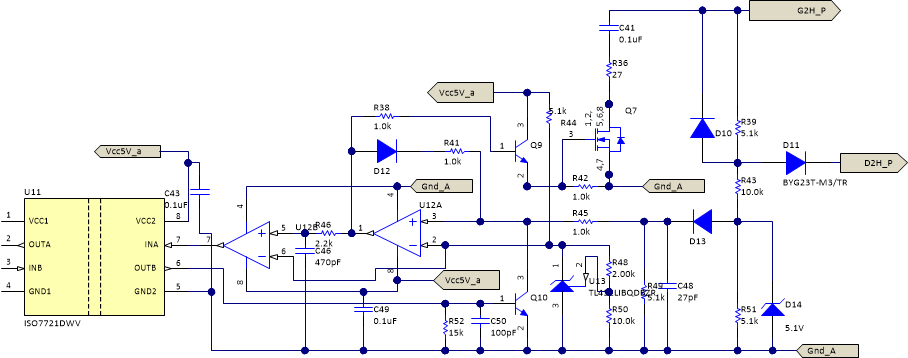JAJU732C June 2019 – July 2022
- 概要
- Resources
- 特長
- アプリケーション
- 5
- 1System Description
- 2System Overview
- 3Circuit Description
- 4Hardware, Software, Testing Requirements, and Test Results
- 5Design Files
- 6Related Documentation
- 7Terminology
- 8About the Author
- 9Revision History
3.5.3 Gate Driver Discrete Circuits - Short-Circuit Detection and Two Level Turn Off
SiC MOSFETs work in the linear region during normal operation. Unlike IGBTs, which have a sharp transition from saturation to active region, SiC MOSFETs have a large linear region and do not have a sharp saturation behavior under conditions with excessive currents. The transition to saturation region happens at significantly high drain source voltage (Vds) and the drain current (Id) reaches significantly high value, which can be as high as 15 times the normal current and can blow out the device. A DESAT detection circuit is necessary to detect this condition and protect the SiC MOSFET.
Figure 3-16 shows the circuitry for detecting short circuits. The diode, D11, interacts with the high-voltage drain pin of the MOSFET. At the start of the short circuit, the current flowing in the MOSFET channel increases dramatically until saturation, and the voltage from drain-to-source also increases and can reach up to the DC bus voltage. The voltage built up across C48 is compared with a voltage reference (3 V) set by the shunt regulator TL431 using the LMV762, which triggers the protection stage to shut down gate driver IC. See the Automotive Dual Channel SiC MOSFET Gate Driver Reference Design with Two Level Turn-off Protection for details on working with this circuit.
 Figure 3-16 Short-Circuit Detection of SiC
Figure 3-16 Short-Circuit Detection of SiCIn the event the SiC experiences a short circuit, it is detected and turned off. During the turn off process, the voltage overshoot can exceed the breakdown down voltage of the device and can destroy the switch completely. To avoid this, a two-level turn off process is initiated where the SiC MOSFET, instead of completely turning off in one shot, is made to turn off at two levels. This helps in preventing overshoot across the switch and keeps it within the safe operating area. Figure 3-16 shows the circuit for the two-level turn off process where a dual comparator, LMV762 (U12A and U12B), is used to initiate turn off by discharging the capacitors of the gate at two voltage levels. The capacitor C41 and R36 form an RC circuit which discharges the gate to a lower voltage level during turn off. The resistor R46 and C46 are used to set the delay time between the turn off transitions.